From 1893 Chicago to Lakemoor Illinois 1981, the history of the Chicago Outfit
I wrote this piece a while back in hopes of using it for the book. For the direction that we wound up going, it was excluded. I wrote it, because I believe that most people don’t understand how the mob works. I thought it best to explain the history first and then second explain how it relates to you and I. I hear today that people think that corporations act like the mob, but that is incorrect. After prohibition the Chicago Outfit modeled themselves after corporations. It was the Robber Barron Era, much like today. They thought that is would be easier to steal with a pen than with a gun. Do you know the first business that the Outfit got into after prohibition? They got into the milk business. I’m not kidding. And the milk business model is the model that they used over and over again to strong-arm themselves into other markets. People always hear about the Teamsters and the mob, but are unsure how they work together. It is such a huge piece to the working of the mob, that not to understand the Teamsters and the mob, is not to understand the mob. This is more of an article then it is a blog so you’ll need some time to get through it. However if you take the time to read it, you will understand the complete workings of the mob. Much of the information that I have learned has come from reading Gus Russo’s book The Outfit. It is an excellent read and I highly recommend it to anyone wanting to learn more about the Chicago Outfit (mob).
_____________________________________________________________________________________
Most people, and in particular those of Chicago, New York, and Las Vegas feel that the Mafia or the mob runs in parallel worlds of our own. That is one of the reasons why people are fascinated by mob members and the stories about them. This is certainly not the case, it’s not parallel worlds but one of the same. The mob influence far exceeds the confines of big cities like Chicago and New York. They shaped our culture, our economics and my life personally. To begin to understand their influence on my story is to understand the roots of The Al Capone Gang, The Syndicate, The Chicago Outfit.
Chicago in the early 1900s was bustling with major growth, and getting its roots as being one of the largest business districts in the world. Chicago was a new modern metropolis due to the rebuilding of the city after The Great Chicago Fire. Railcars were the method of shipping most goods throughout the country. The nation’s largest railway hub is in Chicago, IL. In addition, Chicago took advantage of its access to Lake Michigan and the Chicago River. Lake Michigan gave Chicago shipping routes to the Atlantic through the Great Lakes and to the Mississippi and the Chicago River. Later, the city added major airports to the mix of shipping methods, giving Chicago the ability to ship product anywhere in the world. That attracted some of the words largest manufacturing companies to Headquarter in Chicago, because of the vast shipping modes of transportation.
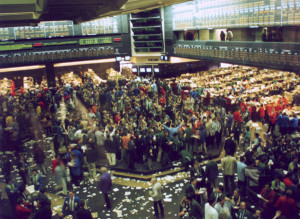
The Chicago Board of Trade, established in 1848, is the world’s oldest futures and options exchange.
Another powerhouse of industry in Chicago was banking. Chicago hosts the Federal Reserve Bank of Chicago, the Chicago Stock Exchange, the Chicago Mercantile Exchange and the world’s oldest futures and options exchange, the Chicago Board of Trade or CBOT (later becoming part of the Chicago Mercantile Exchange).  Chicago today is a player in the global markets and considered one of the top business cities in the world. Most, if not all the world and national banks have a presence in downtown Chicago. The banks finance the growth of the city and Chicago’s commerce. All of this converges in what most Chicagoans and Chicago’s business travelers know as the Chicago Loop.
The Chicago Loop gained its named for the elevated railcars that to this day loop around the downtown Chicago area. What is significant as the revenues of the corporations that transact in this area is that for most of its history it was all part of the First Ward in Chicago. The First ward included the Loop, parts of both the west and south sides of the city. Why is it important to know the ward that had all of this power and money? Because the First Ward was ran by John Coughlin and Michael Kenna. They were two Aldermen that sat on the Chicago City Council. They started their relationship in 1893 and it lasted over a period of fifty years. They were two Aldermen per ward that sat on Chicago City Council back then.
They were the most powerful ward in the Chicago City Council encompassing one of the world’s largest business districts. What relationships could be cultivated, not only on the city level but on the national or even global scale? Would they be Robber Barons, city, state and federal politicians, lawyers, lobbyists, special interest groups, the Chicago Outfit? Were they corruptible? They certainly were.
This is not hard to imagine at all. Look at the state of Illinois today. The city’s dead often vote in most local, state and federal elections. The expression “Vote early and vote often,†coined by Al Capone years ago but still rings with Chicagoans today. Our state governors make our license plates, seeing that in the last three governors including the current as of this writing, two of them are still in prison today. Rod Blodegvich, is the most famous jailed governors at this time, with one of the charges against him is trying to sell the vacant senate seat of President Barrack Obama. To put the level of corruption in Illinois into context, one would say that today’s corruption is the residue of the earlier Chicago corruption. This poses two questions, if it is this bad now what would it take to clean up Chicago politics? And, if it still this bad, how bad was it?
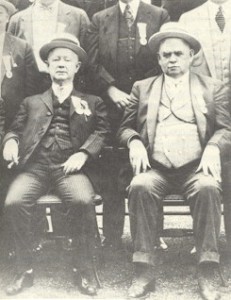
Mike “Hinky Dink” Kenna and John “Bathhouse Johnny” Coughlin. Between the two of them, they ran the Chicago First Ward from 1893 to 1946.
The First Ward Aldermen, John Coughlin and Michael Kenna were nicknamed, Bathhouse Johnny and Hinky Dink Kenna.  John Coughlin was called Bathhouse Johnny because he owned a bathhouse at 145 West Madison in the downtown Loop that catered to gamblers and thieves. Michael Kenna was not only the Alderman in the First Ward, but when the wards were reduced to one Alderman per ward he was appointed Ward Committeeman. Through his positions, Hinky Dink Kenna placed hundreds of Chicago public officials, judges, police captains, legislators, and even mayors into their positions.  These appointments always served the agenda of someone that knew how to lobby the First Ward Aldermen. Imagine the political infrastructure built, or better said, bought, if one established a relationship with these men.
The bathhouse and saloon that Bathhouse Johnny and Hinky Dink owned was in the part of the Loop called the Levee. Â The Levee was the red light district of Chicago, infamous for its brothels, saloons, gambling houses and other businesses of ill repute. Giacomo Colosimo better known as Big Jim Colosimo was one such proprietor. He owned a restaurant-cabaret called Colosimo, right in the Levee, and was acquainted with the Aldermen of the First Ward. Big Jim used to work as a Precinct Captain for the Aldermen. Besides big bands and dancers, Big Jim was better known as the owner of many brothels throughout the city. Through ownership of these brothels, Big Jim was able to gain a stake into gambling and racketeering operations as well. He also started to round up all the corner gangs both around and outside the First Ward under his leadership. Big Jim was the first boss of the Syndicate, or later known as The Outfit.
The Syndicate or The Outfit was able to establish many lucrative illegal businesses that operated with the help of the First Ward Aldermen. However, in 1909 Big Jim faced his first challenge that many successful Italian immigrants would have to face. That was the Black Hand. The Black Hand was from the old country, Sicily, and they robbed wealthy Italians. The Black Hand also would extort regular payments from shopkeepers for protection for their businesses. What they were really protecting the shopkeepers from, was the members of the Black Hand themselves. To counteract the Black Hand, Big Jim called upon his nephew in Brooklyn, John Torrio. Big Jim made John Torrio his second in command. They were able to eliminate the Black Hand threat through their own means and bloomed into becoming two of the most noted gangsters at the time. Big Jim and John Torrio opened and ran brothels together, making large sums of cash and buying influence in the First Ward. While enjoying the life in Chicago, Johnny received a call from a New York City gangster named Frankie Yale. Frankie was concerned with a murder investigation in New York City that might entangle one of his guys and he wanted to send him to Chicago. Johnny Torrio knew the man as he used to work for Torrio back in New York.  The gentleman was now on his way.
1919 was the year of the arrival from New York of one, Alphonse Gabriel Capone, or better known as Al Capone. Yes, this was the beginning of what would become the story of the most famous gangster in history, Al Capone. Al Capone did not start the
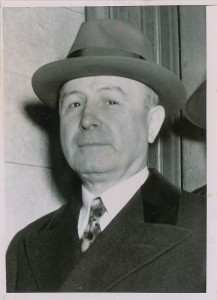
John Torrio or The Fox was the second boss of the Chicago Outfit after having the first boss, Big Jim Colosimo killed.
Chicago Outfit, but he did lead it to become the most notorious gangster on earth still known today throughout the world. Al got his start as a bartender and bouncer at Big Jim and Bathhouse Johnny’s brothels down in the Levee.
Now, we enter the roaring twenties and prohibition. Prohibition was an obvious business opportunity if you had many brothels, speakeasies, saloons etc., and called many major judicial and political appointees as friends. This would promise unforeseen amounts of profits that later proved to be legendary by any capitalist’s standard. Johnny presented the idea to Big Jim Colosimo.
Big Jim was already enjoying much wealth, political influence, and the largest stake in the Chicago underworld. Entering into the market of bootlegging would most likely start a gang war, mainly with the North Siders led by Dean O’Bannon. However good Big Jim’s reasons were for not entering into this lucrative illegal trade, it would still cost him his life.
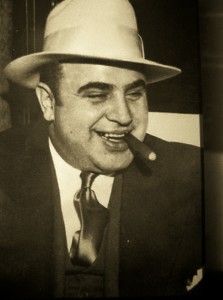
Al Capone was the boss of the Capone Gang, Syndicate, and later the Chicago Outfit. Most notorious gangster known world wide.
On May 11, 1920, Big Jim received a call to come to his restaurant where he was murdered in the foyer of the building. Peoples believe that Johnny Torrio (Big Jim’s nephew by marriage) called on Frankie Yale, the same person that called Johnny on Al Capone’s behalf, to gun down Big Jim. Police question Johnny, Al and Frankie about Big Jim’s murder, but no one was ever charged.
Big Jim had a lavish funeral attended by literally hundreds and hundreds of people. Many of the pallbearers were gangsters, judges, and congressmen. Big Jim was probably the best-connected person in the city of Chicago and now Johnny Torrio would be.
As the United States entered the era of prohibition, The Chicago Outfit as an organization was now ready to utilize its capital to buy politicians, crooked cops and judges. With millions in cash, and all the business partners they needed in and around the city, they were ready to enter the market of bootlegging. Keep in mind, starting with Big Jim’s machine that was making millions in the First Ward alone, the Outfit bought all the connections they garnered for the past thirty years. Whatever Capone’s office in the hotel could not handled, they simply implemented a street fix through their own ranks.
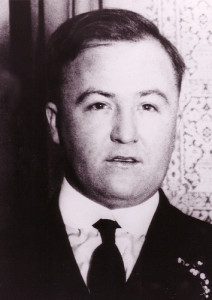
Dean O’Banion was an Irish-American mobster who was the main rival of Johnny Torrio and Al Capone during the brutal Chicago bootlegging wars of the 1920s
Big Jim was right in his prediction that bootlegging would lead to a gang war with the North SIders. This certainly was the ugly part of the business. This led to Al Capone taking over the Chicago Outfit after Johnny Torrio was badly hurt when the North Siders gunned him down. Â Torrio survived the assault, moved back to Italy and gave full control of the Chicago Outfit to Al Capone.
The pay back to the North Siders for hitting Johnny Torrio was the St. Valentine Day Massacre on February 14, 1929. It wiped out almost all of the North Side Gang except for Bugs Moran. After the killings, Moran lost his nerve to challenge Capone any further. This move did one major thing in shaping the Chicago Underworld; it solidified all the gangs under one hierarchy, Al Capone and the Chicago Outfit.
This made the Chicago Outfit unique from the mob in New York.  An executive board comprised of members of the five crime families operated the mob in New York City. Now knowing this, it makes sense why Al Capone was able to become the most infamous gangster ever. They simply bought off the City of Chicago. It was not that they could openly disobey the law, but if they ran into a problem, they paid money out to all who had their hands out. They connected with those at the very top of Chicago’s government who helped make their problems go away.  They made hundreds of millions a year during the best years of prohibition, so paying out graft was just a business expense. They eliminated most of their enemies and went unchallenged in the mid-west. The Outfit extended itself across the country to everything west of Chicago and south to Florida.
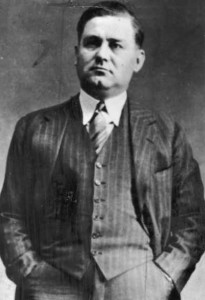
George “Bugs” Moran was a Chicago Prohibition-era gangster for the North Side Gang led by Dean O’Bannon.
A new era and the greatest transition for the Chicago Outfit occurred during post prohibition. Prohibition was ending and the Outfit saw it coming. Alcohol would be a legitimate business again. It would not have the same level of profits that it had during the prohibition era.  The Outfit needed to find a new course of action and it did. Al Capone felt that the Robber Barons of the time were in the right rackets. John D. Rockefeller, Cornelius Vanderbilt, Andrew Carnegie, JP Morgan, John Astor and the many other industrialists that ruled their markets with iron fists inspired Capone and other Outfit higher ups. Al Capone modeled the Outfit after the Robber Barons. It sounds funny in one sense that a mob organization would model itself after a capitalist organization but it is not a far-fetched idea at all.
Robber Barons by definition in the most gentle of terms were capitalist that participated in non-competitive and unfair business practices. In the worse of terms, they participated behind the scenes in bribery, extortion, and murder.  The robber barons monopolized different financial markets, manipulated them and extorted the rest of the markets to capitulation.
Take John D. Rockefeller for instance. He invested heavily not only in the drilling of oil, but also in all the capital required to get oil to the market. Oil, found in centralized spots across the US and requires railroads to transport the oil to refineries and to market.  Rockefeller owned and operated the railroads in consortium with other railroad capitalists that transported their oil and the oil of other oil companies. They raised the cost of transport to other oil companies, giving their own oil companies a competitive advantage with lower costing oil. They also undercut their pricing against their competitors. In the area of refinement, they started to invest and acquire oil refinery companies. This created few oil companies that could compete with Rockefeller in scale, volume, capacity, cost, and distribution channels. They were now only worth what Rockefeller would pay for them. He took over the oil companies and refineries first by raising their cost of transportation of oil forcing non-competitiveness. He then exploited companies that could not compete by forcing them to liquidate in an unfavorable selling position. As they acquired more companies, it increased the pressure on the holdout companies.  They too eventually gave into Rockefeller’s market pressure and sell.

Robber Barons of the Industrial Age from let to right, John D. Rockefeller, Andrew Carnergie, Cornelius Vanderbilt, and JP Morgan.
Robber Barons like Rockefeller knew how to control all aspects of the market including labor. Robber Barons fought fiercely with lobbying and bribery to curb labor legislation and provided an anti-labor front to unionization.
In the example of Colorado coalmines, which Rockefeller was heavily invested in, workers went on strike, the capitalist fought literally, to the death of others, against unionization. This was the Ludlow Massacre. The workers went on strike because they felt their working conditions were unsafe and unjust. In this era, most workers lived in towns built by the company that employed them. The first thing the coal companies did was evict all the striking workers and their families from their company homes. The families moved into tent cities on land leased by the union in preparation for the strike. The coal company hired the Baldwin – Felts Detective Agency to protect the coal company’s interest and to harass the strikers. They did so by shining bright lights on the camps at night, firing rounds randomly into tents sometimes maiming and even killing people. They built an armored car on which they mounted a machine gun and drove around the camps perimeter.  Eventually Colorado’s governor called in the National Guard to temper the situation.
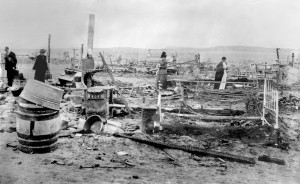
The Ludlow Massacre was an attack by the Colorado National Guard and Colorado Fuel & Iron Company camp guards of 1,200 striking coal miners and their families at Ludlow, Colorado on April 20, 1914.
However, the commanding officer favored the side of the coal company and the robber barons.  A replacement worker was found dead, and the commanding officer ordered the tent city to be burned to the ground in retaliation. The strikers and the coal companies were in a stand off until the spring of 1914 when the state ran out of money to fund the guard. The governor and the coal companies agreed to maintain a private militia. In reality, they were the coal company’s guards but wore the uniforms of the National Guardsmen. Three guardsmen forced a circumstance where they accused the strikers of holding a man against his will. The leader of the strikers met with the militia officer in town. While he was gone, the militia positioned machine guns on the camp of the workers and their families. The strikers tried flanking the machine gun, which led to a firefight that lasted the entire day. Later in the day, a railcar moved into the town and blocked the machine gun placements allowing strikers and the families to escape to the hills. Strikers that did not escape witnessed their camp burned to the ground, and the striker leader, along with other men, captured and later killed by the militia. This prompted another firefight that lasted ten days.  Only when Woodrow Wilson called in Federal Troops to disarm both sides did the fighting stopped. In the government report, it stated sixty-nine people died. In another investigation commissioned by John D. Rockefeller himself, it claimed that 199 people died. In any case, one life lost for the right to work in safe conditions and to earn a fair wage was too many.
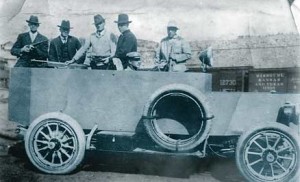
This is an armored car used against the striking coal miners at the Ludlow Massacre by Baldwin-Felts Detective Agency.
I did not pick on John D Rockefeller in particular, but all the Robber Barons in general. They all conducted business the same way. They all reacted by using strong-arm tactics. Exploitation was a common practice among capitalist back in the early 1900s, and arguably now too. They were however, in many ways, worse than the mob could ever be. Therefore, it is not difficult to see why the mob would model itself after the Robber Barons. The only differences between the two were the mob does its own dirty work and the Robber Barons hired legitimate organizations to do it for them. The Robber Barons ran legitimate businesses the Outfit did not. However, that was about to change.
In deciding  the first Robber Baron move, or legitimate business venture the Chicago Outfit would undertake, Murray “Curley†Humphrey’s suggestion to Al Capone “Milk.†Before explaining Curley’s new business model, I should explain whom Murray “Curley†Humphrey was.
Curley was one of Al Capone’s, right hand men and later the same for Tony Accardo. Accardo leaned heavily on Curley much more so than Capone did. Tony ran the Outfit from the mid 40’s to his death in 1992. Adopted by a judge, Curley used his intelligence and legal acumen to serve The Chicago Outfit. He was very smart and was the organization’s political fixer and legal strategist. He was significant in building The Outfit’s new business model influencing it all the way into the 1960’s. A final interesting note about Curley was that he was Welsh. The Chicago Outfit is unique in that they allowed non-Italians to hold high positions in the organization. He could not be a made-man because he was not Italian. However, I am not sure of what courtesies of a made man he did not receive, but Curley was just as well respected. No one ever denied his significant influence, nor was his leadership ever challenged.
Curley had to articulate to Capone what or why he had a fascination with the milk business. He argued that a small number of people bought alcohol and only a few of which indulged in drinking nightly.  Most would buy a few bottles of beer for the weekend. Milk however, was poured on a daily basis many times a day in most households. Alcohol at the time was a beverage of men and a small number of women. On the other hand, everyone, men, women, and children in one form or another consumed milk.   It was the beverage of children, used in cooking and baking by women and added to coffee by adults. Curley asked Capone, “What if we could get a few pennies from each glass?†Capone now understood why milk, but also how they were going to get into the milk business.
What became the recipe for breaking into new markets by the Chicago Outfit is what they did to break into the milk industry; took over the unions. We often heard that the mob was involved in unions but I am not sure if most understand how. Like the milk industry, the Outfit looked into putting their men in or near the top leadership in the union. They did so by calling in a favor from a friend, forcing an enemy at gunpoint to put Outfit people in at the top. By doing so, they got their influence and control over the workers and they utilized this in many folds. First, they got access to the union’s dues that they pilfered from, and took their cut. What were much more lucrative were the unions’ pension funds. They could be in the millions to hundreds of millions. The Outfit might not be able to go to a bank for a loan but they could go to the union to borrow the pension money. The green dollar found by extorting the union is one form of revenue. However, there was a great amount of “blue†dollar money gained here as well. When a union backs a politician, everyone in the union is encouraged to vote for that candidate.  They also campaign vigorously for the politicians they supported. This is the very kind of support that every politician would relish. The union becomes a small army of political influencers or a large sales force for their politician. The Outfit used this by making promises to sitting and potential politicians’ victories. They also wrapped up a very important variable in any market equation and that is labor itself. When The Outfit penetrated the milk unions, they leveraged the workers against the dairy farmers.
When they became more powerful with the milk unions, they moved in on the dairy farmers’ truckers union. They made the dairies pay tribute to them to resolve labor disputes that the mob created. For those that could not pay, they took over the dairies. Eventually, The Outfit owned most portions of the milking industry in the mid-west. Whatever holdouts remained, The Outfit had a capitalist solution to the problem. They went to the Chicago City Council and lobbied for laws that the holdouts could not comply with, just as the major corporations lobbied for laws to create favorable market conditions. The law that the mob lobbied for that we all should be thankful for, is the grading of all dairy products. Today when we purchase our Grade A milk, we can thank The Chicago Outfit. They got a law passed that only Grade A milk could come into the city limits and lesser grades could not. They did not do this out of a mother’s concern of serving her child spoiled milk. They did this because the capital investment required to date and time stamp the bottles, equipment to test and produce the graded milk and dairy products, economically destroyed most of the holdouts. The Outfit in a short period took over the regional industry. Think about it, if you could get a few cents for every glass of milk poured in three or four states, how lucrative would it be? Some of the revenue would come from the legitimate stakes owned in the milk producing businesses. In addition, the Outfit was skimming or exploiting money from each level of production to the distribution of milk. They had regular dues paid by union members from which The Outfit got their cut. The Outfit had a huge line of credit that extended to the organization backed by union pension funds. Many politicians after receiving bribes allowed themselves to enter office to serve the interest of the Chicago Outfit over the needs of their constituents. It is mind boggling the money and the influence of just one market. The balance sheet of this organization would put it in Forbes’ Top 500 Fastest Growing Privately Held Corporations and come with a Moody’s triple AAA rating.
In comparison of the John D Rockefeller examples and The Outfit’s penetration of the milk market, there is little difference. The Robber Barons and The Outfit both strong-armed labor, and used tactics too illegally or unfairly lowered the cost of their goods while raising the cost of their competitors.  This created such an imbalance in their micro-economies that they would gain exponential growth that led to market monopolization. They both lobbied for legislation that served their own interest. Robber Barons and the mob are both directly and indirectly responsible for the murder of many people. The differences that I can only think of are two. Robber Barons were able to publicly meet, speak to and fund their political friends. What they did was legal and called lobbying and making political contribution. When the mob does this it is called conspiracy and bribery. When the mob kills to get what it wants, it is usually with a precision assassination of an individual or a small number of individuals. When Robber Barons killed to get what they wanted, they hired detective services and local thugs to murder indiscriminately many workers or union sympathizers in riots or street battles.
The Chicago Outfit members were primarily, capitalists. They were murderers, extortionists, thieves, arsonist and other things, secondly to serve the first, capitalism. They used the “Milk Business Model†on many industries; casino operations, movie business, meat-packing, truck driving, gambling machine manufacturing, vending machine distribution, liquor and beer distribution, parking, dry cleaning, construction, waste disposal and many other legitimate industries. Their illegal businesses were very lucrative as well. Gambling, prostitution, loan-sharking, and extortion were huge moneymakers for The Chicago Outfit.  The one variable that I have not discussed in all these equations is you and I.
Since the tentacles of The Chicago Outfit are everywhere, you and I contribute to their empire and we do so unknowingly. We all buy goods and services, and part of that money goes back to the mob. We do not notice it because itemized quotes and proposals do not include Chicago Outfit Tax and Protection. It is included in the cost of our transacting for goods or services. We can be paying this tax in form of a legitimate stake holding in a market. Sometimes we pay a tax created by extortion and pass it onto the consumer as an additional cost in the form of a higher price. In any case, prices rise but are not disclosed to us as the Outfit’s cut. A real life example was my father’s taverns.
My father had cigarette machines, jukeboxes, pinball machines, and arcade machines. All coin operated devices. Tavern owners rarely owned these machines because they are expensive. Additionally, in the case of jukeboxes, the records needed changing often, and pinball machines and arcade machines rotated to keep the patrons interest. These machines sometimes rented, but more often, the revenue was on a split. The man that serviced and rotated our machines I knew as Mickey “The Jukebox Guy.†I liked Mickey a lot. Whenever I saw him, he would give me a ten-dollar roll of quarters for the machines or set me up with all the free games that I could want. One of the reasons why I liked him so much was that he had a shooting game that I loved to play. It was one of those large arcade machines of years past. It had a machine gun mounted to shoot soldiers and tanks. I still remember the name of the game- Ambush. He gave me that machine. I was the only kid with a full size arcade machine in his bedroom. Another thing that I knew was that Mickey was a member of the Chicago Outfit. My father did not use Mickey because he was an Outfit member, but it was much simpler than that. In the Chicagoland area, you used Mickey or somebody that he knew. I am sure Mickey did not introduce himself to my father by saying, “Hi I am Mickey the Jukebox Guy from the Chicago Outfit and I am here to make sure that we get our cut.†When you are in need of vending equipment, you don’t get a large selection of vendors from whom to choose. When Mickey showed up to service the machine and collect the coins, he was just picking up his split. They did not sit down and go one for Ron, two for Mickey and three for The Outfit and so on and so forth.  These coins came from you and me when we would play music or arcade machines or bought cigarettes. If you have never visited a tavern, maybe you have bought some milk. Or you may have gone to Las Vegas, or contracted for construction, had garbage service, paid to see a movie, or parked your car in a private parking lot. Okay you get the idea; our money funnels to the mob in many ways.  This is true of all us who have been around since the 1970’s or longer.
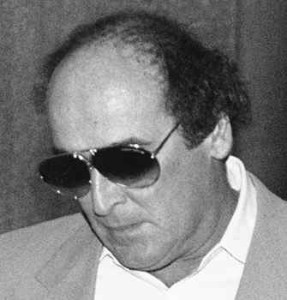
James Marcello was the boss of the Chicago Outfit until he was convicted in the Family Secrets Trial for the murder of Tony and Michael Spilotro and other RICO charges.
I have a side note about Mickey that I have learned later in life. Mickey was half brother to Chicago Outfit boss James Marcello. They both were convicted in the Chicago’s Family Secrets Trial for RICO (Racketeer Influenced and Corrupt Organizations); conducting an illegal gambling business; obstructing a criminal investigation; and tax fraud conspiracy in 2007.
With a firm understanding of the way The Outfit makes their money and the tremendous wealth it creates, we can start to ascertain their political influence on our society. Now we can appreciate the validity that the Mob elected John F. Kennedy president, or certainly influenced the outcome of the election. I think most historians would promote this as historical truth, or at least not argue this or say they did not know. I don’t believe any would say it wasn’t true.
Joseph Kennedy Senior was not only a capitalist; he was also the US Ambassador to Britain during World War II. In the era of prohibition, he was also a bootlegger, and one of the biggest. He shipped alcohol up and down the coastline of the US and Canada. He had to work with many of the mob controlled liquor rackets. He knew and met with the top men of many of the mob factions, especially of those in New York and Chicago. All politicians back then had to get the unions behind them to win any election. It is the equivalent of the panhandling that politicians do today with lobbyists to secure their election. Joe Kennedy knew this as well, and he met with many of the different heads of the mob families that he knew from his bootlegging days. He asked them for union support for his son’s candidacy for President. He got it and the unions support was critical for some key strategic wins like the state of Illinois. This is also why many think Bobby Kennedy’s investigation of the mob did not really reveal much. Anything that Bobby did find also led back to his father and his influence on his brother’s election. Political analysts and mob historians believe that the Outfit influenced two other Presidential elections, a Supreme Court Judge, and numerous senators and representatives.  To understand what the Chicago Outfit achieved in wealth and influence on a National level is to look at what they achieved on their own home turf.
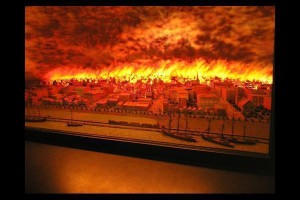
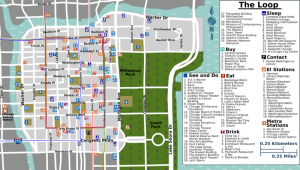
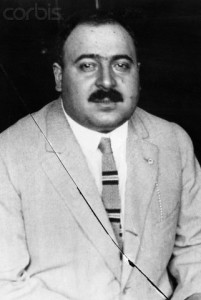
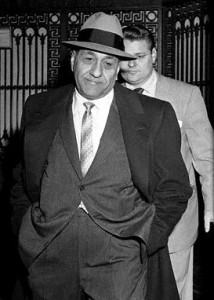
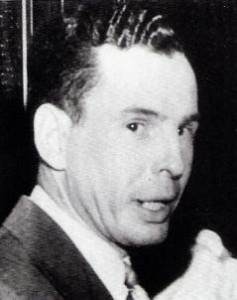
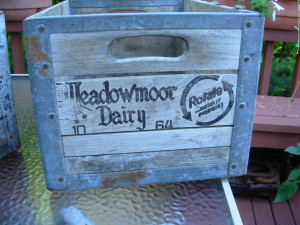
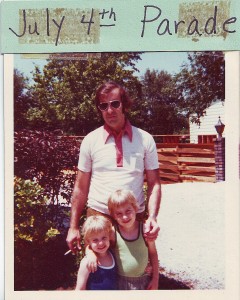

Paul,
Murder in McHenry is now available for Kindle owner/readers.
Had an interesting call this afternoon, Paul. The lady who contacted our publisher regarding the triple homicide in McHenry in June of 2011 called to speak to me about the case. The way she described the investigation, it sounds like a cross between your father’s murder investigation and the one “conducted” with Gary Gauger.